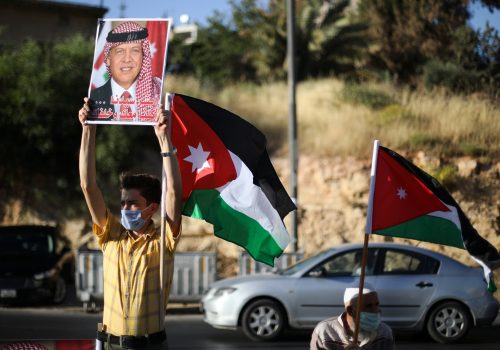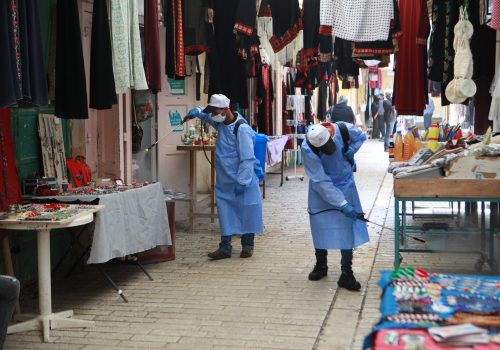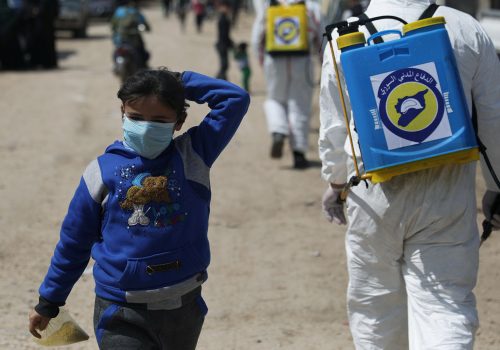What lies ahead as Jordan faces the fallout of COVID-19
On June 28, Jordan’s Health Minister, Dr. Saad Jaber, boldly declared that the coronavirus had “dried up and died in Jordan.” Dr. Jaber backtracked days later by renewing calls to adhere to necessary safety measures. Amid fears of a second wave, the Hashemite Kingdom of Jordan continues to stand out among its neighbors, as it exhibits an impressively low rate of infections. Jordan—made up of nearly 10 million people—recorded just over one thousand COVID-19 cases and nine deaths since reports surfaced back in early March.
What makes Amman’s handling of the coronavirus pandemic unique lies less in the specific measures imposed, but more so in the swift and aggressive fashion by which they were carried out. Data compiled by Oxford University’s Blavatnik School of Government rendered the level of severity in Jordan’s governmental response to the pandemic, or its “stringency index,” increased from 80 percent to 100 percent during mid-to-late March. In comparison, scores for bordering Iraq and Lebanon floated around 80 percent.
Jordan’s King Abdullah II spared no time in reacting to and preventing the rapid spread of the virus, a devastation that would have overwhelmed the country’s health services. On March 17, with slightly over thirty confirmed cases, King Abdullah issued a royal decree that activated the Kingdom’s 1992 Defense Law. Article 2 of the law grants sweeping powers to the prime minister during exceptional circumstances “that would threaten the national security or public safety in all parts of the Kingdom.” To address concerns over abuse of power, Jordan’s Prime Minister Omar al-Razzaz assured the Jordanian public that the law would be implemented in the “narrowest extent” possible as he enforced a state of emergency.
On the ground, strict lockdown measures translated to daily street patrols, mandatory curfews, and the forced shuttering of businesses and restaurants across Jordan. By March 19, the Jordanian Armed Forces sealed the capital city of Amman—comprised of over four million residents—and prohibited movement between governorates. Soon after, international travel was suspended, returning Jordanians from abroad were quarantined, schools and universities were closed, and public worship at mosques was banned. The government went so far as to offer citizens doorstep delivery of essential goods and sent truckloads of subsidized bread to distribute throughout different Amman municipalities.
At the beginning of May, Iraq and Lebanon registered over two thousand and seven hundred confirmed cases, respectively, with over one hundred combined deaths, according to the World Health Organization (WHO). In contrast, the Kingdom witnessed five hundred cases and eight deaths. Keeping early evening curfews in place, the government slowly eased restrictions in specific governorates across the country. By June 6, the majority of businesses reopened alongside restaurants and mosques, signaling a major step toward Jordan’s return to normalcy.
Public trust in the government is positive, for now
Despite the disruptions to Jordanian life, the pandemic has presented an unlikely opportunity for the government to prove itself in re-capturing public trust. In the eyes of Jordanians, the government’s approach has generally been perceived positively. A survey conducted by the University of Jordan’s Strategic Studies Centre on June 24 showed that 92 percent of Jordanians considered the government to have been successful in controlling the pandemic. However, it remains to be seen how the response to the pandemic will improve or sour the relationship between the government and its citizens in the long run. For now, Jordan appears to have “salvaged some of its image with the quality of its response,” according to Abul-Wahab Kayyali, a research associate at Arab Barometer.
Jordan’s approach to flatten the curve is a short-term solution. Safeguarding public health has adversely affected its already fragile economy and has disproportionately impacted the livelihoods of the most vulnerable. Such challenges will likely turn public opinion negative and fuel new waves of discontent, as previously seen in the austerity protests of 2018 and recent teachers’ protests of 2019.
The economic outlook is dismal
The hard road to economic recovery is, perhaps, the principal hurdle to enabling the structural reforms necessary to counter subdued economic growth. In April, the World Bank forecasted the economy to shrink to negative 3.5 percent of gross domestic product (GDP) in 2020 due to a significant downturn in both global and domestic demand. Jordan’s travel and tourism sector—constituting 13.8 percent of GDP—saw a 56.5 percent drop in revenues in the month of March. As international travel remains constrained, the sector is projected to be “the last to recover” according to Tourism and Antiquities Minister, Majd Sweikeh. Labor force participation rates will also continue on a downward trajectory, coinciding with a sharp climb in unemployment, which stood at 19 percent before the pandemic. Furthermore, Gulf Cooperation Council (GCC) countries experiencing similar weak prospects for growth will cause lower foreign direct investment and reduced remittance flows. These combined factors will weigh substantially on Jordan’s economic outlook and further strain public debt at $42 billion—about ninety-seven percent of GDP.
Finance Minister Mohammad Al-Ississ announced that government revenue decreased by $849 million within the first four months of the year, increasing the likelihood of a higher-than-anticipated budget deficit for 2020. Al-Ississ also expects Jordan’s economy to contract by 3.4 percent, slightly below previous calculations. “Our tough measures were painful but important” admitted the minister, but Jordan must confront an “economic war against the virus” moving forward.
In a move that appeared to soften the blow of the pandemic for employers in the most affected sectors, PM Al-Razzaz amended Defense Order 6, permitting employers to cut workers’ salaries by up to 30 percent in the months of May and June. Khaled al-Zubaidi, a contributing writer for Ad-Dustour Daily, argued that the decision hurt hundreds of thousands of employees who were already struggling to meet their financial obligations. He also warned that slashing salaries would generate significant “living and social pressures.”
Jordan secured extra lending from international financial institutions to buffer against the unexpected shocks of the pandemic. The International Monetary Fund’s (IMF) $1.3 billion extended facility fund program with Amman, which was originally negotiated prior to the outbreak of the pandemic, was adjusted in March to support necessary emergency spending. Later in May, the IMF approved Jordan’s request for $396 million worth of emergency assistance under the fund’s Rapid Financing Instrument (RFI).
The added external financing measures are instrumental for Jordan’s medium-term stability. Nevertheless, to set up for long-term sustainability, Amman must strike a balance between public safety and reviving the economy in order to honor both internal and international obligations. If unsuccessful, the government may face a complete overhaul of its unraveling social contract, forced by the hands of those who face the brunt of the economic pain.
The livelihoods of the most vulnerable remain unprotected
Jordan holds the position as the second largest host of externally displaced peoples per capita in the world. According to the United Nations High Commissioner for Refugees (UNHCR), there are approximately 657,287 registered Syrian refugees who reside in Jordan. Of these, over 13 percent make up the country’s population, with 84 percent living in urban areas. Recognizing its distinct demographic challenges, Jordan is figuring out the best ways to ensure an inclusive socio-economic framework with support from external donors.
On June 11, the World Bank approved a $100 million financial assistance package aimed at creating jobs and enhancing work conditions for both Jordanians and refugees. Saroj Kumar Jha, World Bank Mashreq Regional Director, deemed that the project will “contribute to improving the living conditions, economic prospects, and resilience of Jordanian host communities and Syrian refugees.”
The new commitment by the World Bank echoes past initiatives that targeted the incorporation of non-Jordanians and refugees, many of whom are stuck in the informal sector, into a more formalized labor market. Despite government promises to guarantee two hundred thousand work permits for refugees, as outlined in the London Initiative’s Jordan Compact of 2016, only 138,000 have obtained work permits in 2019 based on recent UNHCR reports. Cindy Huang, a non-resident fellow at the Center for Global Development, prescribes that the next phase of the Compact should enable a more competitive business environment, while eliminating barriers to job accessibility and expanding women’s workforce participation.
The World Bank predicts that the human capital gain from providing adequate social safety nets could add 0.4 percent to GDP growth in Jordan. Refocusing reforms to protect the Kingdom’s refugee populations and corresponding host communities serve as a key to unlock greater potential that will stimulate the kind of economic growth Finance Minister Al-Ississ and others envisage.
Jordan’s resiliency will continue to be tested in 2020 and beyond
Looking ahead, the most immediate challenge—apart from Jordan’s domestic struggles—include the impending Israeli annexation of the West Bank. King Abdullah’s vocal and staunch opposition may drive a wedge between Jordan’s relationship with the United States—one which the Kingdom benefits substantially from. Therefore, the current climate is of great political hazard for Jordan, who received $1.3 billion worth of aid from the United States in 2019. Bruce Reidel, a senior fellow at Brookings, reasons that “Jordan cannot risk jeopardizing foreign aid in the midst of the pandemic and the associated economic crisis.”
Facing a triple crisis—public health, economic, and social—the primary question will be if the government can assuage the fallout of COVID-19. The muddled mix of uncertain regional geopolitical dynamics on top of mounting internal demands will force Jordan to re-calculate its policy orientation. Amman has proven its resiliency over the years, however, only time will determine if the country can live up to expectations and deliver on its promises.
Emily Santucci is an intern with the Atlantic Council’s Rafik Hariri Center for the Middle East.
Image: A teacher wearing a protective suit checks the temperature of a child at a nursery after the government eased the coronavirus disease (COVID-19) restrictions in Amman, Jordan June 8, 2020. REUTERS/Muhammad Hamed


